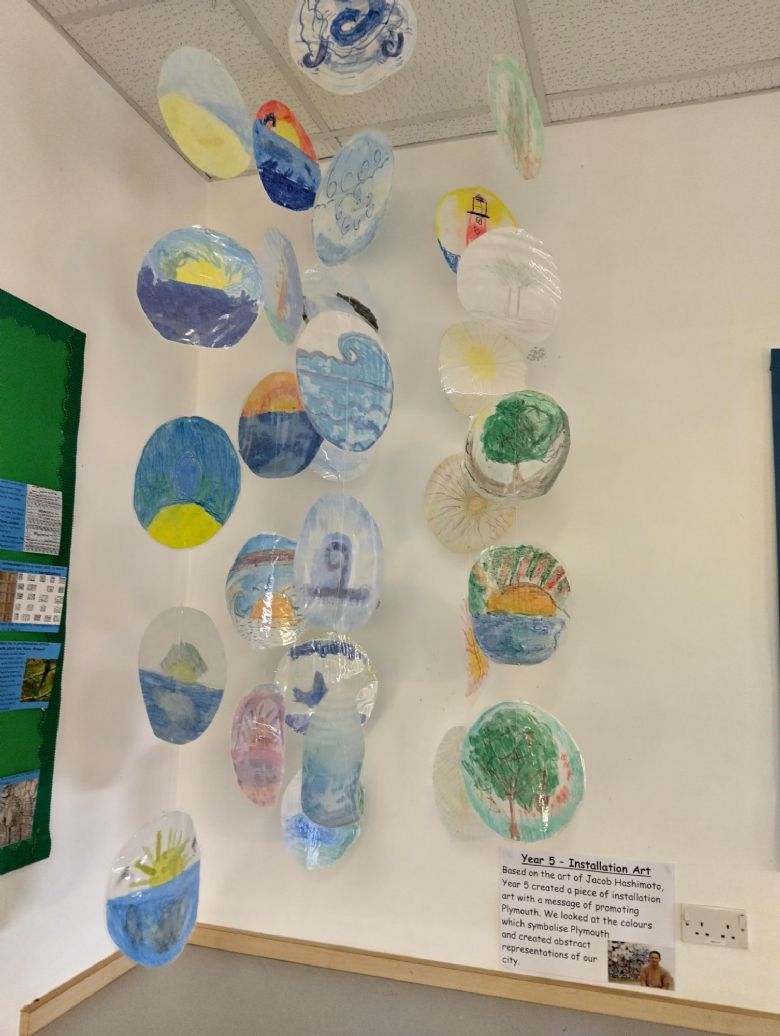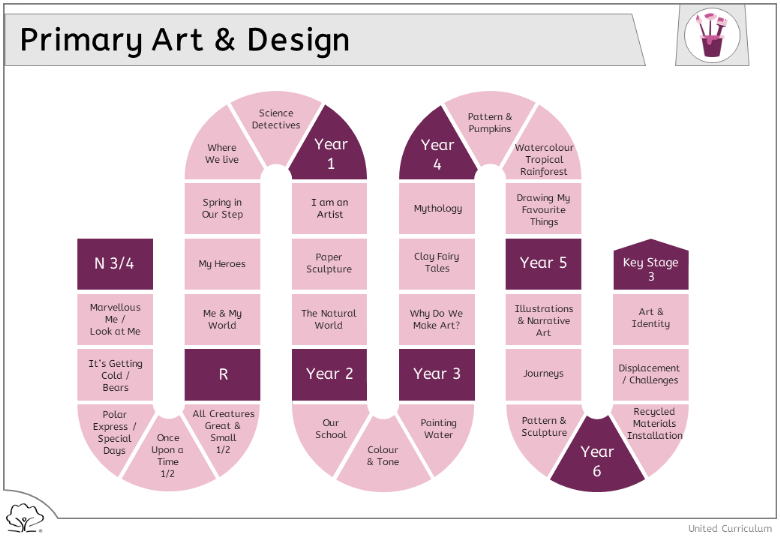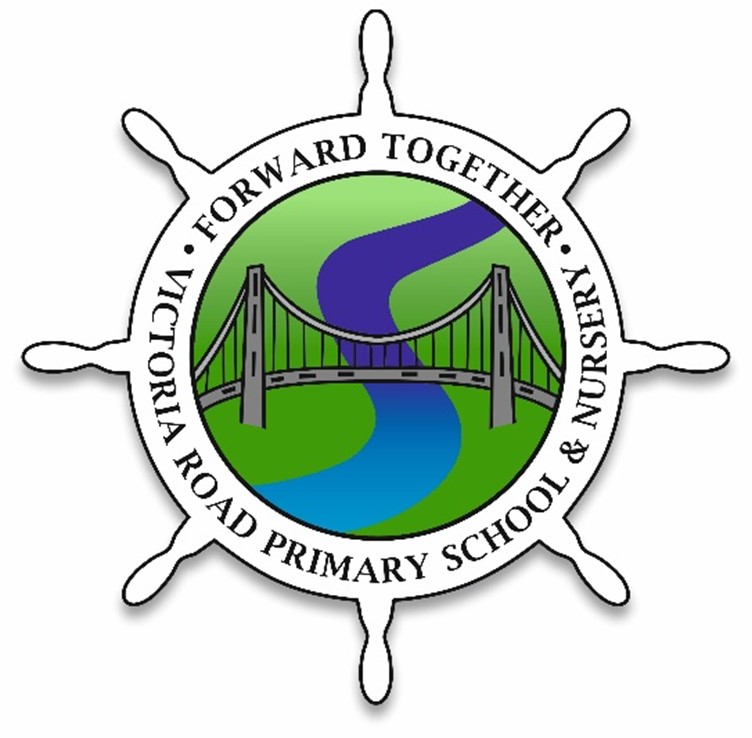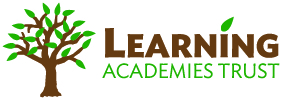Art and Design
" Art is not what you see, but what you make others see."
Intent - Why do we teach what we teach?
At Victoria Road Primary School, we believe that every child has the right to a curriculum that enables them to have a creative outlet and have a range of artistic experiences. We understand the immense value that having the ability to express themselves creatively provides for children’s emotional wellbeing. At Victoria Road Primary School, children will;
- Be taught with the aim to meet the National Curriculum Objectives for their year group
- Gain a toolkit of skills to enable them to express themselves creatively in a range of ways.
- Develop a good understanding of different types of art including drawing, form, printing and textiles.
- Experience a range of different types of art through studying different artists including local artists.
- Be immersed in Art so that they are confident and competent at drawing with scale and perspective and are able to represent their imaginative ideas in a physical way.
- Feel safe enough to express themselves without judgement or comparison with an understanding that the enjoyment of artwork is subjective and differences in opinion are celebrated when studying art.
- Take ownership of their own progression in art by focusing on self-assessment and gaining from verbal feedback from their teachers.
Please see the document Art Progression of Knowledge and Skills for a detailed overview.

Implementation - What do we teach and when?
|
We ensure a range of skills are taught and then built upon later in the children’s school career. Specific skills are mapped and taught at least twice during their time at Victoria Road. This enables children to build upon prior knowledge and progress in ability and understanding of different techniques. An emphasis is placed on the understanding of colour and drawing is an expectation in every unit of art, with some units having a specific drawing focus. The curriculum promotes practical learning, which is collated in sketchbooks. Large, 3D, experimental work is encouraged and photo evidence is collected. Units teach targeted skills in order to build up to a final piece designed and planned by the children. Units are usually planned to link in with termly topics to add to the immersive learning experience of a creative curriculum. Teacher marking in the sketchbooks is discouraged in order to maintain pride and care of the children’s creative works. In place of this, Teachers:
Pupils:
|
When teaching art, teachers aim to create a safe environment where children feel brave enough to take risks and think outside of the box. They recognise that for some children, confidence can be a barrier in art and use ice-breakers and other tools to encourage these children.
Impact - How children show that they know and remember more?
|
Children are assessed against the national curriculum and skills maps throughout the year. A list of children’s ability to achieve ARE in Art is collated and re-assessed throughout the year in order to pass this on to the subsequent year group teacher. This assessment is made based on observations of the children’s skills, completed submissions of learning at the end of a unit and a teacher’s overall judgement of a child’s aptitude. |
The knowledge and skills taught can be applied in different contexts throughout the year and there are many other opportunities for art in addition to the 3 units per year through special events like RE/Art week. A scrutiny of work is also carried out at least once per year to ensure the quality of teaching is upheld and that each project is meeting the specific skills outlined in the progression of skills map
Art Knowledge and Skills Progression Map
- Curriculum Map 2023-2024
- EYFS Art Progression
- combined-art-and-dt-23-24-kapow Knowledge and Skills progression
National Curriculum
Academic Year 2024-2025
Principles of the Art Curriculum
Intent: Why do we teach what we teach?
The United Curriculum for Art provides all children, regardless of their background, with;
- Entitlement - Regardless of their starting point, the curriculum allows pupils to produce creative work, to explore ideas and develop the confidence to excel in a broad range of artistic techniques. All pupils will learn about artists and cultures from across history and the world.
- Coherence - Taking the National Curriculum as its starting point, the curriculum is sequenced from Early Years to key Stage 2 and beyond so that the pupils gradually develop and build their practical knowledge, including the formal elements, the use of a range of materials in two and three dimensions, and the techniques required to produce artwork. Theoretical and disciplinary knowledge is sequenced so that pupils build a deeper understanding across key stages.
- Mastery - All pupils will be explicitly taught about the formal elements - colour, form, line pattern, shape, texture and tone - and other aspects of knowledge in small steps. Pupils will revisit, develop and apply their skills with increasing technical proficiency.
- Adaptability - Our Art curriculum is designed to give teachers flexibility, allowing them to select and adapt resources for their specific context. Art is brought to live for the pupils by supplementing it with artists from their local area.
- Representation - The Art curriculum provides children with the opportunity to explore historical and contemporary artists and artworks, who represent their own and others' cultures, values and beliefs. We will explore the context in which art was produced, and consider the full breadth of human experience and expression through art.
- Education with Character - We aim to build and maintain pupils' confidence in their ability as artists to create. The curriculum will develop aspects of character such as resilience, confidence and risk-taking. Through the curriculum, pupils are given opportunities to share, reflect and learn about each other's experiences whilst recognising the things we have in common.
Implementation: What do we teach and when?
The implementation of the United Curriculum for Art & Design reflects our broader teaching and learning principles:
For Art & Design in particular,
- Content is always carefully situated within existing schemas. Every unit considers the prior knowledge that is prerequisite for that unit and builds on that knowledge to develop a deeper understanding of that concept. For example, pupils are not expected to be able to produce a representational drawing until after they have explored a range of drawing materials and have had the opportunity to experiment and create using a range of materials, techniques and processes.
- Vertical concepts are used within lessons to connect aspects of learning. In Art & Design, this is most clearly evidenced in the progression of knowledge and skills linked through the formal elements (line, tone, space, shape, form, colour, pattern and texture). These building blocks of the subject offer opportunities for pupils to develop their knowledge and understanding as well as their practical skills.
- Disciplinary knowledge is explicitly taught to pupils and carefully sequenced to ensure pupils are provided with opportunities to practice these skills throughout the curriculum. Pupils are encouraged to engage with big questions about the meaning and purpose of art, as well as exploring the concept of creativity in both a theoretical and very practical way. Our purpose is to allow our pupils to see themselves as artists by developing their innate creativity through building their confidence in knowledge, understanding and skill.
Curriculum Road Map 2024-2025
The following road map shows the units being covered by each year group.

The following table shows when each unit is being taught.

The United Curriculum for Art and Design has been adapted by considering the context of our pupils and the community.
For example:
- Pupils learn about local artists and their work, both past and present.
- In Yr1 Summer, pupils have the opportunity to explore the natural environment around their school building and record their findings using art techniques.
- In Yr2 Autumn, pupils explore their school environment and consider the work of designers and architects in relation to their own built environment.
- In Yr4 Summer and Yr6 Summer, pupils are encouraged to explore and celebrate their identity through artwork.
- In Yr5 Spring, pupils have the opportunity to record a journey they have made, during which they explore the local area through the study of maps.
Impact: How children show that they know and remember more?
The careful sequencing of the curriculum - and how concepts are gradually built over time - is the progression model. If pupils keep up with the curriculum, they make progress. Formative assessment is prioritised and is focused on whether pupils are keeping up with the curriculum.
In general this is done through:
- Use of sketchbooks and pupil-conferencing - Pupils use the same sketchbooks over multiple years, until they are complete. Sketchbooks contain a record of pupils' progress over a significant period of time. Talking to pupils about their sketchbooks allows us to assess how much of the curriculum content is secure. These conversations are used to determine whether pupils have a good understanding of the vertical concepts (practical knowledge), and if they can link recently taught content to learning from previous units.
- Formative assessment in lessons - There are opportunities in the lessons, and teachers continually adapt their lesson delivery to address misconceptions and ensure that pupils are keeping up with the content.
- Low-stakes summative assessment - We also use low-stake quizzes at the end of the unit to assess whether pupils have learnt the core knowledge for that unit. These are also used formatively, and teachers plan to fill gaps and address misconceptions before moving on.

